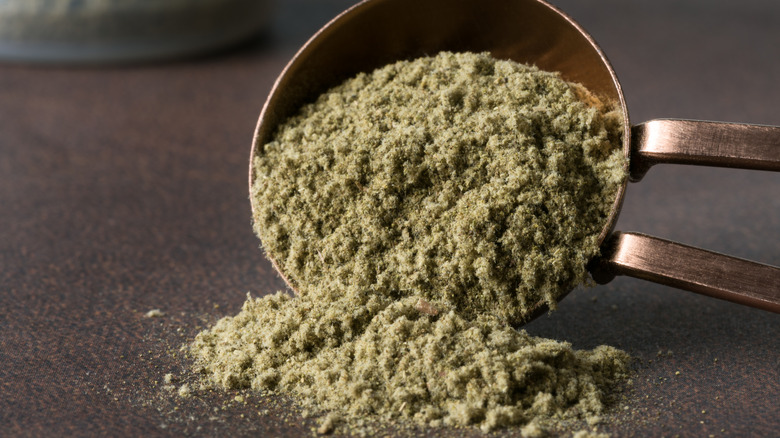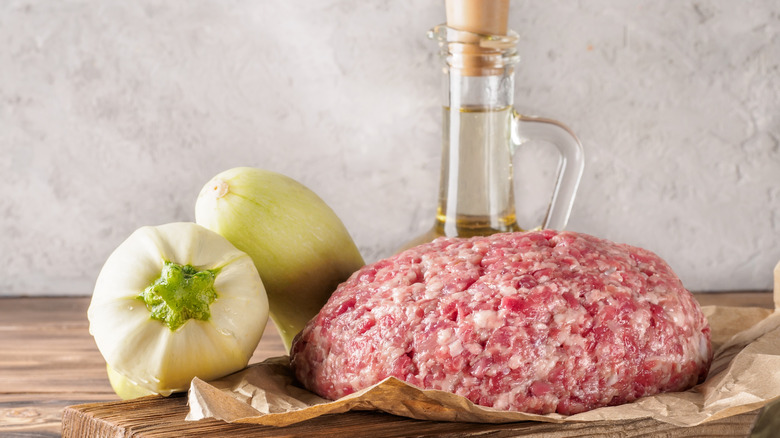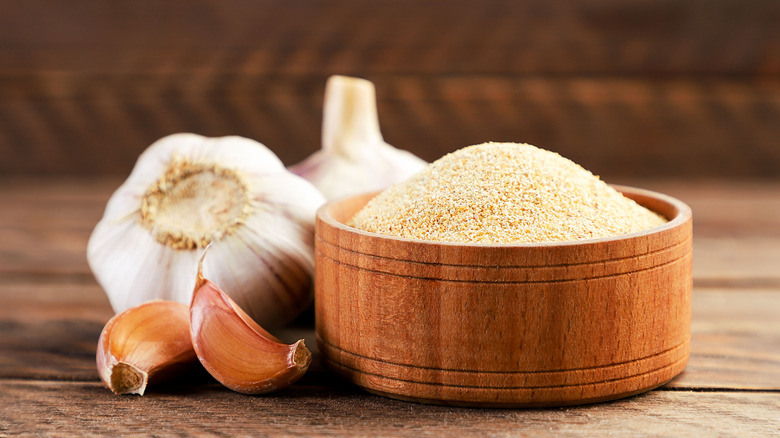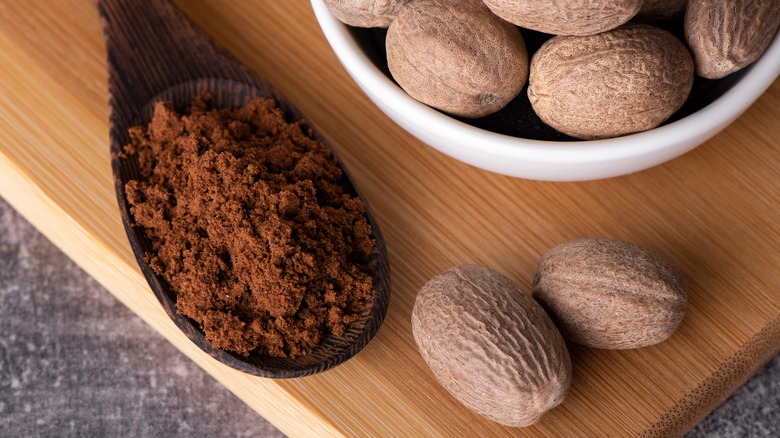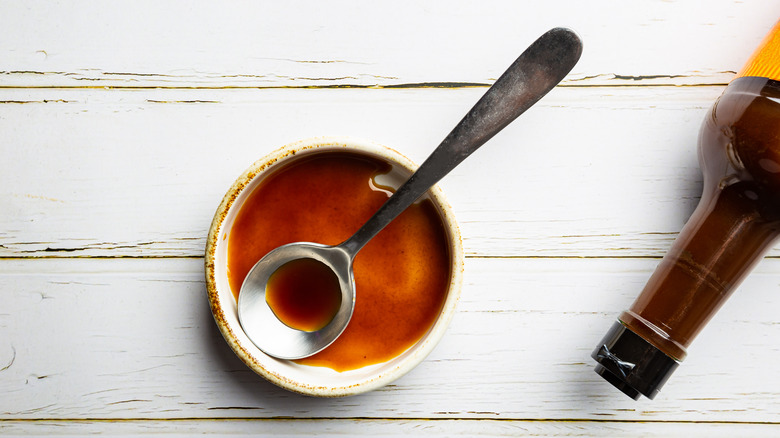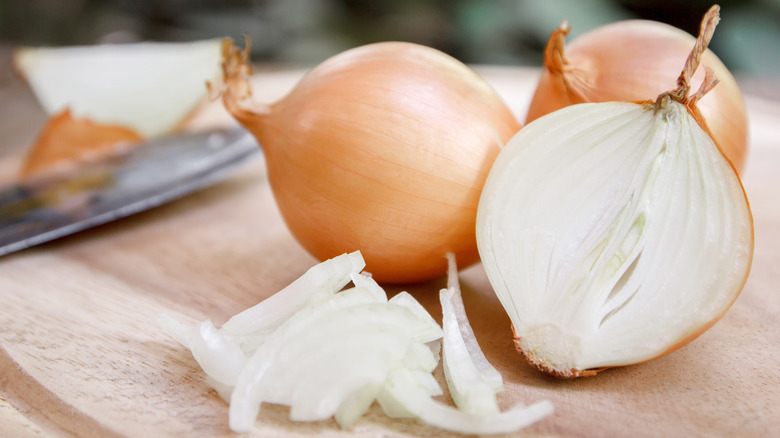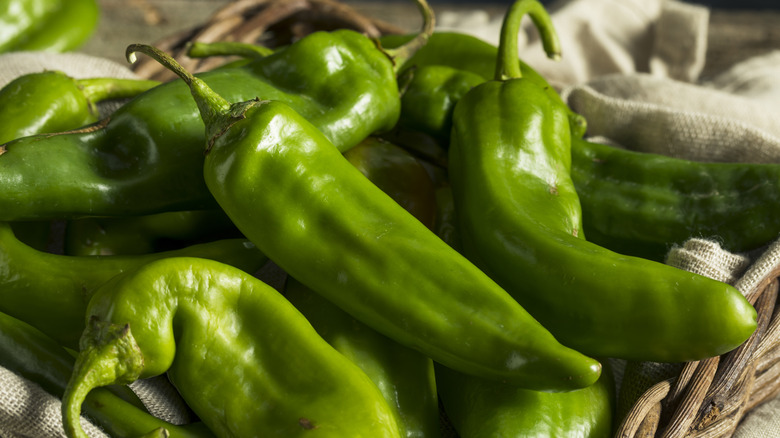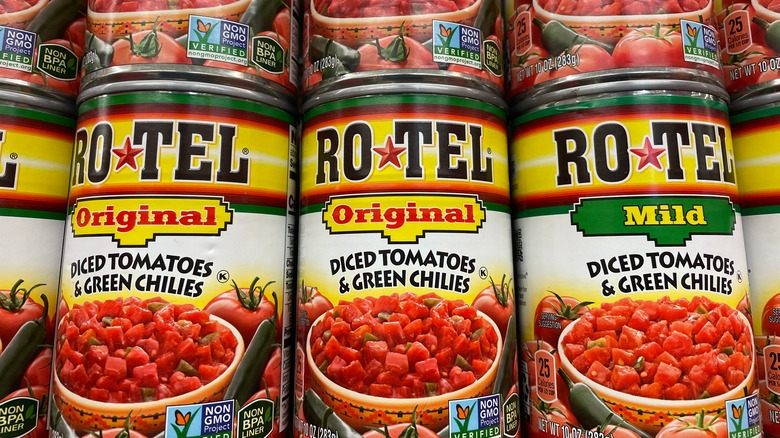Ingredients That Will Seriously Upgrade Your Sausage Gravy
Breakfast is said to be the most important meal of the day. If you want to start your morning with a satisfying and savory dish, a heaping spoonful of sausage gravy poured over warm, buttery biscuits is never a bad way to begin.
A classic sausage gravy recipe starts with a velvety bechamel-based sauce that is infused with bits of browned breakfast meat, spices, and plenty of black pepper. Most often, it's served on fluffy, warm biscuits, but it's also delicious on waffles, grits, hash browns, and even mashed potatoes.
While traditional sausage gravy is a nearly perfect breakfast staple, consider including a few unexpected elements that add sweet, savory, and spicy flavors to add some variety to your plate. There are a handful of ingredients that can upgrade this classic dish and turn it into a showstopper. You don't have to use all of these ingredients together. In fact, we advise against it. Too much of a good thing, and all. Rather, choose one of two of these unique elements to create the perfect flavor profile.
Real butter
A velvety sauce starts with a roux. A roux is a fundamental technique in cooking that uses equal parts fat and flour to thicken sauces and gravies. To make a roux for gravies, you'll start by heating fat in a skillet. Since pork often leaves rendered fat after cooking, you can use some of that fat to create your base. But, as you'll want at least two tablespoons of fat, you may want to compensate with butter.
The fat content of real butter is best for a roux, and we do recommend using butter instead of margarine. You can use salted or unsalted butter without affecting the final result. Unsalted butter is preferred by many cooks as it allows salt levels to be adjusted more easily while cooking. Margarine can work in a pinch, though it is made of vegetable oil instead of cream, has higher water content, and, in some cases, added components that can affect the final taste and texture of the gravy.
Whole milk
Once the roux is golden in color and frothy, it's time to make things nice and creamy. Adding milk creates a classic béchamel sauce which is one of the five French mother sauces (via Escoffier). In most cases, whole milk is widely preferred when making béchamel. Whole milk has a fat content of 3.25%, per the Washington Post, and this fat content is what creates a thick, rich sauce for sausage gravy. If you substitute with skim milk, you could end up with a finished product watery in composition. As for a plant-based milk alternative, you may end up with the same consistency problems as well as an undesired, naturally sweet taste that's often found in nut and oat beverages.
Full-fat dairy has, unfairly, gotten a poor reputation in the past. In more recent years, it's been proven that real butter and full-fat milk are not as bad for you as initially believed. A recent study published in The American Journal of Clinical Nutrition points out that a former correlation between full-fat dairy and heart disease may be mistaken. In fact, the study suggests that full-fat dairy may have protective benefits against certain conditions — when consumed in moderation, of course. Create a rich and silky dish using whole milk, and rest easy knowing you're getting loads of flavor with potential health benefits.
Ground sage
With a hearty base in place, you can start getting creative with ingredients that can upgrade your decadent sausage gravy. Certain spices, like ground sage, offer up amazing flavors to enhance a basic blond breakfast sauce. Sage provides an earthy, woodsy taste that goes perfectly with pork. According to SPICEography, the citrus and pine notes found in sage can cut the richness of a dish and accentuate the minerality of certain ingredients. This is particularly true in dishes with fatty meats and dairy components, making the porcine notes of sausage gravy a prime companion for ground sage.
Ground sage is a powder made from finely ground dried sage leaves, and it has a more pungent flavor than fresh sage (via McCormick Science Institute). If you're using either ground sage or dried sage leaves, add them early on in the cooking process to allow the flavor to soften before serving. You could also use fresh sage in this morning meal, but as fresh herbs have a more mild taste, it is best to add fresh sage near the end of the cooking process or as a finishing garnish.
Thyme is another savory herb you could use alongside or instead of sage. Thyme tastes like a minty or lemon-esque cousin of sage, both herbs sharing earthy notes, and either fresh or dried thyme works well in this breakfast-time favorite. Fresh thyme will have a cleaner, brighter taste than dried thyme but can pair beautifully and uplift your meal.
Homemade sausage
You don't have to stick to a half-frozen roll of meat to make this biscuit-topping sauce. In fact, using your own homemade breakfast meat is an excellent way to create a custom gravy recipe. The best ground meats start with the right protein for the job. As LiveStrong notes, sausage is packed with proteins, and making it from scratch gives you more choice in the quality of meat, reducing fillers, and improving the overall nutritional profile. Pork is most often used, but our homemade turkey breakfast sausage recipe is a lean and tasty alternative. You could even mix a little diced bacon into your ground meat mixture for rich and savory notes that are perfect for the breakfast table.
Kick up the flavor levels of homemade sausage by creating your own spice blend. Ground sage is a popular and ideal pairing for rich and fatty meats. Dried or fresh thyme leaves add an earthy essence. Experiment with spices and ingredients like fennel seed, rosemary, allspice, celery seed, or even a sprinkle of brown sugar to get the perfect early-morning protein combination.
Vegan sausage
This might surprise you, but you can absolutely make this breakfast recipe without using actual meat. While the deliciously rich and silken blond gravy is a great topping for biscuits on its own, try one of these picks for the best vegan substitutes for sausage to add more texture and taste to the dish. Many popular vegan options do come in patty or link form, but you can break them up before cooking or use a meat chopper as you brown them in a skillet.
To make the sauce entirely vegan-friendly, skip the whole milk and use unsweetened and unflavored plant-based milk. In our opinion, hemp, macadamia, and pea milk have the least amount of natural sweetness for baking. If you need more fat content in the roux, use vegetable or olive oil in place of butter. You can even make vegan biscuits by using some helpful tips and recommendations for vegan baking substitutions. Don't feel like making biscuits from scratch? Try your homemade vegan sausage gravy on breakfast potatoes or hash browns instead.
Maple syrup
If one of the biggest challenges you face each morning is deciding between a sweet or savory breakfast, we've got you covered. Adding a bit of real maple syrup to your sausage gravy recipe adds the slight saccharine profile you crave to a hearty and savory meal. We recommend always choosing real maple syrup over a maple-flavored option because the real version will lend a mellow maple taste without being overly sugary or sweet.
What is the best way to tell real versus fake maple syrup flavored bottles? Read the ingredients. Look for pure maple syrup as the one and only ingredient on the list, and this will help you avoid the sticky substitutes. You'll also have to remember to store your syrup in the refrigerator. If you don't refrigerate maple syrup, it can spoil like other fresh foods. Keep it refrigerated to avoid the growth of mold and bacteria. Plastic containers do allow air in, so storing maple syrup in a glass or tin container can keep it fresh and spoil-free for up to a year (via USDA). And if you keep it that long, you'll be able to find many other unconventional ways to use real maple syrup.
Depending on how sweet you want your breakfast food to be, you could also amp up the sappy taste in this breakfast recipe by opting for maple-flavored protein options rather than original or sage-infused varieties.
Garlic powder
Using garlic powder adds a mild piquant flavor to any dish. It is a convenient and long-lasting ingredient that gives dishes a garlicky essence without any peeling or chopping. Fresh garlic can become overpowering in recipes and has a pretty assertive flavor. Adding this allium in powder form softens the taste and allows other ingredients to shine. If you do happen to have some fresh garlic that is teetering on the not-so-fresh-anymore fence, try dehydrating it in the oven and make your own garlic powder at home to use in your next batch of breakfast gravy.
How do you know how much garlic powder to use in your recipe? SPICEography notes that one clove of fresh garlic is equal to about ⅛ teaspoon of garlic powder. We recommend no more than ¼ teaspoon in a batch of sausage gravy. And for a slightly bolder taste, there are an abundance of garlic powder hacks that you can employ to coax stronger expressions from jars that may have been sitting on your spice shelf for too long.
Ground nutmeg
If you're a fan of meals that make you pause in a good way, try adding nutmeg to the next sauce recipe you make. Wondering how to use nutmeg to upgrade your sausage gravy? It's simple. Normally an ingredient added to seasonal baked goods, nutmeg adds a nutty warmth to béchamel-based sauces that other spices and ingredients can't quite reproduce. And its particular softness pairs perfectly with both sausage and silky gravy.
Nutmeg comes as a whole seed that can be grated into a meal, or you can buy it already ground into a powder form. When using it in a cream sauce, a little goes a very long way. This is especially true if you're grating it directly into the food. Freshly grated nutmeg has a higher potency, and you'll get the unique flavor by using very little. When adding ground nutmeg to this dish, ⅛ teaspoon is plenty. If you do find yourself with a whole nutmeg seed, you can also use it to elevate your mashed potatoes or sprinkle it into a béchamel for an ingredient that will change your lasagna forever.
Worcestershire sauce
Worcestershire sauce isn't just for mixing a Bloody Mary or Caesar dressing, though those are two of its most popular uses. It has many other purposes and, in fact, it is the secret ingredient Alex Guarnaschelli uses in many of her savory dishes. Worcestershire sauce is a fermented fish sauce that lends a briny yet sweet and acidic taste to any meal. Sausage gravy is no exception, and this early-morning meal pairs well with all of the complex flavors found in this well-known multi-use condiment.
Some home cooks don't realize that the surprising ingredient in Worcestershire sauce is anchovies. The little fish are fermented for 18 months and are what give the sauce its unique salty taste. Along with anchovies, you'll find molasses, salt, vinegar, tamarind, and a few other flavor-packed elements. Using Worcestershire in this savory meal adds an unexpected note that, much like nutmeg does for cream sauces. Leave your hungry breakfast guests wondering what that perfect undertone of flavors could be.
Lemon juice
Sausage gravy is not a light food. It is rich, and it's hearty, and can be quite heavy as a breakfast meal. Acid and fat are two of the four primary cooking flavors, and in particular, the two that happen to balance one another (via the Independent). Using acid to cut through some of the richness of a cream sauce is a great way to lighten up the taste. In fact, adding acid to cream sauce is one of the best secrets to making incredible sauces. Lemon juice adds brightness and depth of flavor to a luscious blond gravy by allowing you to taste more than just fat and dairy.
Fresh lemon is key here. Using bottled lemon juice can add an off-putting, artificial, or sour taste to your food. We should state that sourness is not the same as acidity. But, adding a squeeze of fresh lemon, no more than two tablespoons, will elevate the taste of your gravy and help the flavors of the meat and herbs shine through. You can also try this lemon juice trick in your favorite chicken fettuccine recipe or even to spice up your jarred alfredo.
Yellow onion
Onions improve the taste and add a zesty savoriness to almost any dish they're used in. These versatile flavor-makers are affordable, easy to cook with, and come in several varieties, so you can find the perfect onion for your palate. While you can experiment and try cooking with every type of onion, yellow onion is a match made in heaven for this decadent breakfast recipe.
Also known as the Spanish onion, yellow onions are a go-to for most recipes that call for alliums and are ideal for sautéing and caramelizing. They have a great depth of flavor, and when cooking onions, yellows offer a light and sweet taste that provide more mild acidity to balance your creamy breakfast staple. Be sure to chop them finely (we suggest mincing) and cook them low and slow for quite a while to trigger the Maillard reaction, which will caramelize them and bring out their sweetness. Add them to your protein just before it finishes browning to punch up the flavor of your sausage gravy.
Hatch chiles
If you haven't noticed by now, pairing sweet, spicy, and acidic notes in a sausage gravy recipe is the key to success. How about an ingredient that covers all the bases? Hatch chiles are a variety of pepper that is commonly used in breakfast recipes found in the Southwest and Midwest. They are drier in taste than bell peppers, and these unique regional chiles offer a balance of mild spiciness, sweetness, and a slight acerbic bite to a dish. Hatch chilis can be found raw in many grocery stores, but it is easiest to find them diced and packed into affordable cans.
Hatch chiles also have an earthier taste than some of their other chile pepper counterparts. This could explain why they pair so well with savory powerhouses like sage and thyme and are featured in many sausage varieties and sauces. To use hatch chiles in this dish, dice them up finely, as you would an onion, and cook them right along with your protein before starting the roux. You could also roast them prior to adding them to your dish, which brings out the rich, smokey notes that are waiting to be expressed from the chile.
Cayenne pepper
There's an abundance of reasons you should keep cayenne pepper in your pantry, and sausage gravy is one of them. Kick up the warmth in your breakfast sauce by adding a dash of heavy-lifting heat. This spicy powder is made from whole cayenne peppers, which register 30,000 to 50,000 Scoville units compared to the jalapeno, which hits 5,000 units (via Scovillescale.org). A few pinches of cayenne pepper will add some serious intensity.
Cayenne pepper is also the base of many hot sauces, and you can absolutely add a few shakes of your favorite spicy condiment into this breakfast dish in place of cayenne pepper. The best hot sauce brands will have heat and acidity that blends beautifully with sausage gravy rather than standing out as an independent addition. While we're all about getting creative and experimenting with ingredients, you will likely find a more successful pairing with Mexican or American-style hot sauces for this breakfast dish rather than sauces with Thai-inspired flavors.
If you want to boost the taste of your dish but are a bit more heat-averse, try using paprika instead of cayenne pepper. Paprika imbues notes of zinging warmth without being inherently pungent.
Ro-Tel tomatoes
The unexpected ingredient that will change your sausage gravy forever can be found in a brightly labeled can on the shelf at your local supermarket. Ro-Tel tomatoes add the perfect amount of acidity and just the right bit of zestiness to this classic breakfast recipe. Tomatoes offer an excellent addition of acid to rich and creamy dishes while also bringing an inherent tanginess, too. And the chiles included in each can of Ro-Tel add a spicy and bold taste. We really couldn't ask for a better pairing for our early morning meal.
Ro-Tel offers a variety of options to upgrade your sausage gravy. Choose from original, mild — or, if you're a spice-seeking food lover — go for a can of the hot. Ro-Tel's fire-roasted version erupts out in smokiness and rolls a unique flavor throughout your gravy. We love serving this Ro-Tel-infused sausage gravy over a plate of scrambled eggs, a bowl of cheesy grits, or on a pile of well-seasoned home fries.



